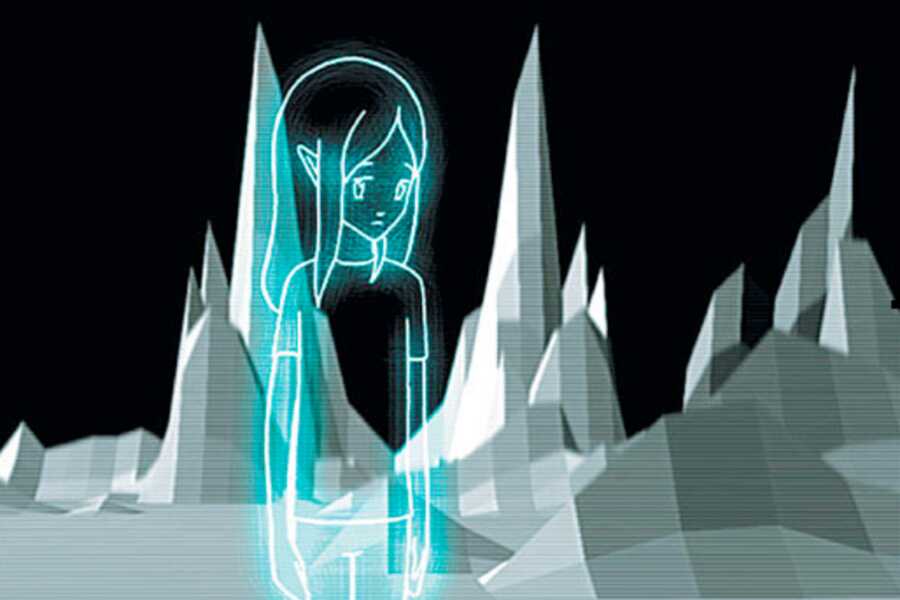The role of the spectator — or witness — in this ever-changing tension between presence and representation similarly forms a crucial topic in major art historical debates, even though with a new intensity since the emergence of the technological media in the 19th and 20th centuries. “The arts requires witnesses,” as Anne Wagner recalls the words of the 18th century writer Jean-François Marmortel in her essay, “Performance, Video and the Rhetoric of Presence” (2000, p. 61). The digital media — or so-called “new media” — have further complicated this age-old problem of witness and presence, which Huyghe recognizes in his AnnLee project, No Ghost Just a Shell (1999-2000), of which the video Two Minutes out of Time is a part. In another work of this collaborative project, One Million Kingdoms (2002), Huyghe draws an analogy between the actual landing on the moon and the invention of digital space, both of which opened up previously unknown yet imaginative territories. In this animated film, we witness AnnLee walking through a lunar landscape that is mapped out and developed on the intonations of a narrator’s voice, which recites actual recordings of Neil Armstrong mixed up with excerpts of Jules Vernes’ science fiction, A Journey to the Center to the World (1867). The underlying message is clear: AnnLee’s march through digital space can be seen as “a giant leap for mankind” just as Armstrong’s historic moon walk (3).
The AnnLee videos are a good example of the way in which Huyghe investigates questions of presence in contemporary media culture and society, but the greater part of his oeuvre deals with topical issues of presence and representation, including the roles of observing and being observed within it: from the billboard Chantier Barbès Rochechouart (1994), to the double projection The Third Memory (2000), and his more recent, large-scale project A Journey that Wasn’t (2005),” Huyghe reveals the intricate levels of reality which, as Rosalind Krauss puts it, “retreats behind the mirage-like screen of the media” (Krauss 2004, p. 48). As evident from Krauss’s word choice in the full quote of Art since 1900, she disapproves of those media: “Two kinds of absences structure the field of aesthetic experience at the end of the twentieth century into the twenty-first. One of them we could describe as the absence of reality as it retreats behind the mirage-like screen of the media sucked up into the vacuum of the television monitor, read off so like so many prints-out of a multi-national computer hook-up” (2004, p. 48). Yet, the fact that reality is concealed behind “the mirage screens of the media,” as I argue in my dissertation The Problem of Media in Contemporary Theory (1960-1990), is not a persuasive reason to avoid addressing one of the main issues — presence — related to contemporary means of representation (4). German media theory has taken the complex issue of presence at a time of advanced media conditions more seriously. Oliver Grau, for instance, includes a chapter on “Tele-presence in his Virtual art: from illusion to immersion, in which he investigates the question of presence through the perspective of the (new) developments in robotics, tele-communications and virtual reality. He also discusses projects by pioneering artists in this context, such as Ken Goldberg, Eduardo Pac, Simon Perry and ART + COM (Grau 2003). Chris Salter published an equally important book, Entangled: Technology and the Transformation of Performance, in which he deals with tele-presence in chapters such as “The Projected Image” and “Interaction” (Salter, 2010). This idea of tele-presence — presence over a distance — is a crucial one in performance art in general because of its common use of video, as Wagner shows in the already mentioned essay, but it takes on different forms with the new interactive possibilities of the computer and Internet. More comprehensive books on the arts and the media also came out, in which topics related to presence and representation are being discussed. For example, Future Cinema: The Cinematic Imaginary after Film, edited by Jeffrey Shaw and Peter Weibel (Shaw and Weibel, 2003), and the scholarly Media Art Histories by Oliver Grau (Grau, 2007). The first book is a huge catalogue published on the occasion of an all-inclusive exhibition on expanded cinema at the Center for Art and Media in Karlsruhe, which also featured the work of artists engaged with (tele-) presence and representation, such as Shaw’s own projects on virtual reality, Blast Theory’s explorations of the boundaries between real and virtual presence, and Jordan Crandall’s early work in which he employs military targeting technology to probe new modes of representing (or tracking) presence. The second book is a first serious attempt to reconsider art history from the perspective of science, technology, and media. It includes a wide range of articles that intersect with the subject matter of presence in different ways, such as Weibel’s paper on early forms of virtual art, Louise Poissant on the interface and Sean Cubitt on the screen.
--------------------------------
Note 3: Armstrong spoke the following legendary words when he set foot on the moon: "That's one small step for [a] man, one giant leap for mankind.”
Note 4: The textbook Art since 1900 is divided into two volumes, one for art from 1900 until 1945, and another for art since 1945. While it is justifiable to not discuss media in the visual arts before 1945, when the term ‘media’ was still only in use within the field of advertisement, it becomes problematic in the second volume on art in the postwar period.


